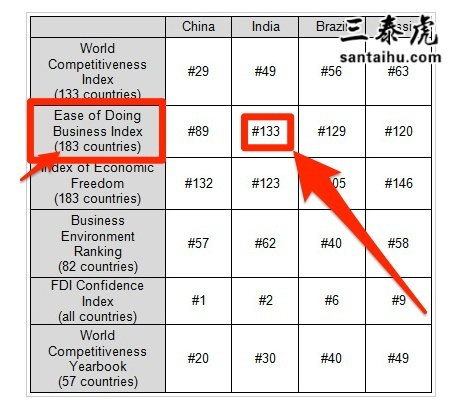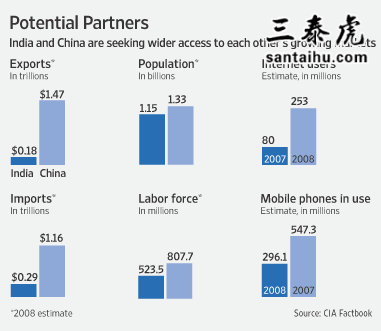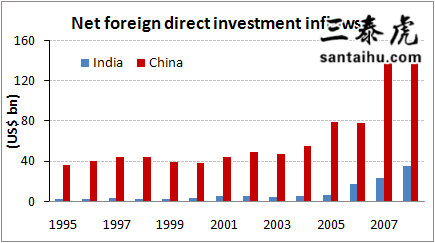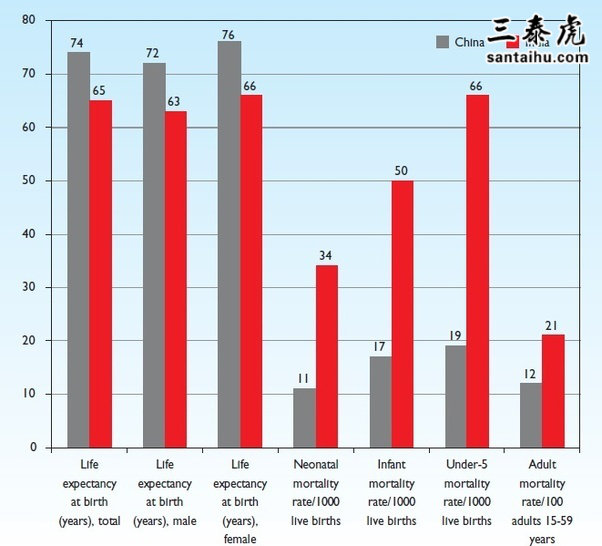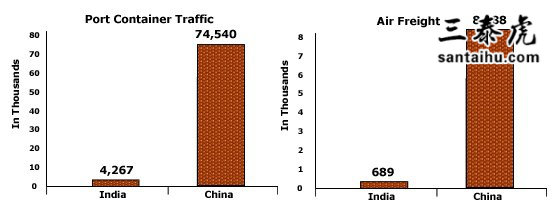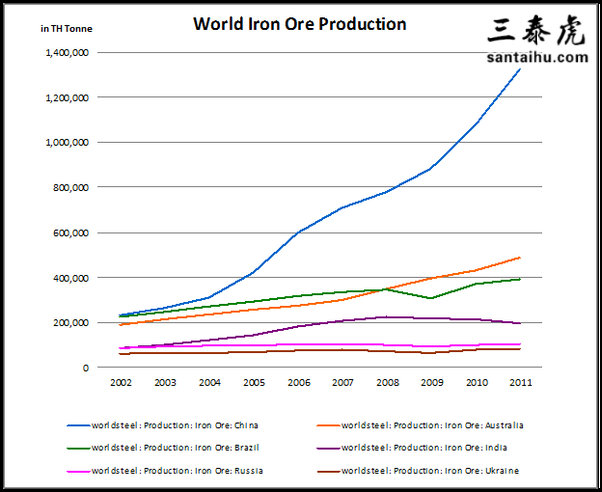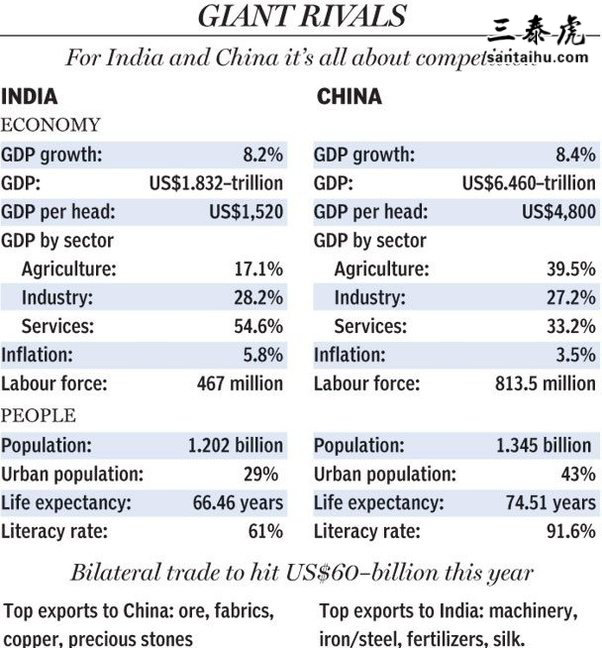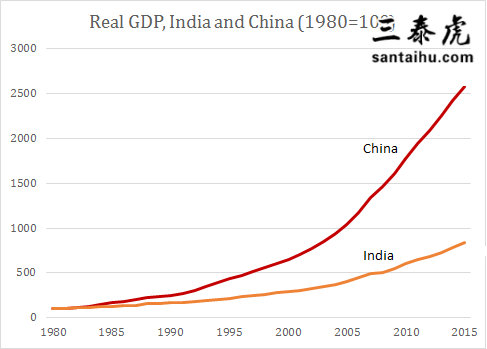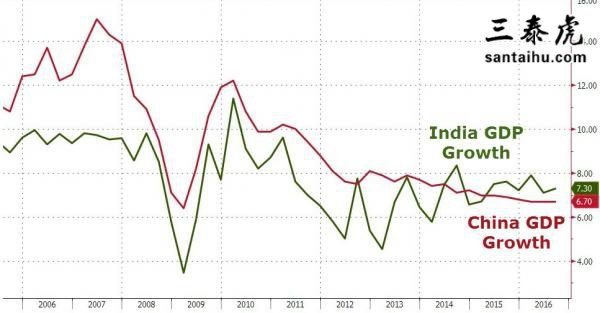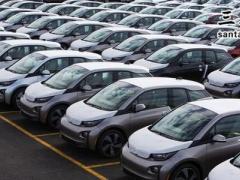美版知乎:中国对印度有什么优势
What are China's advantages over India?中国对印度有什么优势?QUORA网站读者评论:Balaji Viswanathan, Knowledge loverMor
What are China's advantages over India?
中国对印度有什么优势?
QUORA网站读者评论:
Balaji Viswanathan, Knowledge lover
More friendly to business and investment
Yesterday, I was at LinuxCon in Chicago - a major business/tech convention and was chatting with execs on setting up businesses in India. With a beer in hand, each recounted their horror stories in setting offices in India. They are all well meaning business folks and each could have brought a lot more well-paying jobs & better tech. But, no.
In India, we are still living in the 19th century business & trade environment, still debating on Walmart's entry to India and FDI. China is lightning years ahead. They allowed Walmart to set shop 18 years ago, revolutionized their retail and extremely ahead in logistics, while we are in stone age retail. That is just one sector, but the same is everywhere.
Look at our world rank below on ease of doing business. I get it that it takes years to construct roads, dams, airports etc. But this is just ease of doing business, almost entirely dependent on our attitudes. We have to change our anti-business attitudes. Anti-business lobbies should be pushed out. Nehruvian socialism has turned us too cynical and against our businesses.
更友好的商业和投资环境
昨天,我在芝加哥参加LinuxCon——一个重要的商业/技术会议,和公司高管们谈论在印度建立企业。每个人手里拿着啤酒,讲述了在印度设立办事处时经历的恐怖故事。他们都是善良的商人,每个人都可以给印度带去更多高薪工作岗位和更好的技术。但是,没有。
在印度,我们仍然生活在19世纪的商业和贸易环境中,仍然在讨论沃尔玛进入印度和外国直接投资。中国已经领先我们好多光年了。18年前,他们就允许沃尔玛开店,彻底革新了他们的零售业,他们在物流方面非常领先,而我们的零售业还处于石器时代。这还只是一个领域,各个领域都是如此。
看看我们在全球商业便利度的排名吧。我明白建造道路、水坝、机场等需要花费很多年时间。但这只是商业便利度,基本上完全取决于我们的态度。我们必须改变我们的反商业态度。反商业游说应该取缔。尼赫鲁的社会主义让我们过于愤世嫉俗,不利于我们的商业。
译文来源:三泰虎 http://www.santaihu.com/46574.html 译者:Joyceliu
China vs. India: Which is better for doing business?
中国vs印度:在哪个国家好做生意?
See India's exports below vs. China's. Good luck trying to grow it by driving away foreign investment.
看看下面这个印度和中国的出口额对比图。要赶走外国投资来发展印度的出口贸易,祝你好运。
In every indicator of capitalism - trade, investment, competitiveness and ease of doing business, China is way ahead.
在资本主义的每个指标中——贸易、投资、竞争力和商业便利度——中国都遥遥领先。
China's health is way ahead:
Mao might be c-- for a lot of things. But, in many ways he was also a pragmatist. One of the key innovations of his time was this: Barefoot doctor. These were semi-educated village doctors who dramatically improved health outcomes in the rural areas. Instead of producing only a few 1000 doctors who got through a 7-year school, why not produce 1 million doctors who go through 1-year school have basic knowledge of diseases and sanitation? This is very important for a nation growing up. China’s village doctors take great strides
India failed to do this and focusing only on Western-style Medical education. Thus, we have too few doctors to take care of 600,000 villages. As China crossed the stage 1, they abolished the Barefoot doctors and are busy in stage 2. This and other healthcare innovations show up in the stats below.
中国的民众健康领先我们:
毛是一个实用主义者。他的时代最重要的创新之一就是赤脚医生。这些受过一定教育的乡村医生,极大地改善了农村地区的健康状况。与其只培养几千名通过7年制医科学习的医生,为什么不培养100万名完成1年制学习的具有疾病和卫生基础知识的医生呢?这对于一个国家的发展非常重要。中国的乡村医生大踏步发展。
印度就没有做到这一点,只注重西式医学教育。因此,我们的医生人数要负责600000个村庄,实在太少了。当中国跨过第一阶段后,他们取消了赤脚医生,开始了第二阶段。这和其他医疗保健创新可以通过下面的统计数据看到。
How can a sick under-nutritioned nation grow fast?
民众营养不良的国家怎么可能快速发展?
China's Infrastructure
Nothing more to say here. China has got some of the fantastic roads, railways, ports, etc. I will just use one statistic to dramatically drive home the point.
中国的基础设施
没什么可说的。中国有一些很棒的道路、铁路、港口等等。我只要用一个统计数字就能说明这一点。
Size and resources
China is more than thrice the size of India with way more water, energy and mineral resources. I will give you one example of iron ore. See the blue lines vs other lines.
规模与资源
中国的水量、能源和矿产资源比印度多三倍多。我给你举一个铁矿石的例子,看看蓝线和其他线的对比。
Going through its labor peak due to Demographic dividend
China and India have comparable population, but China has 80% more workers than India. How? It is because of temporary condition of Demographic dividend where a number of new kids drop rapidly and a significant portion of the population are the kids of yesterday - who are now healthy adults ready to work. The nation can focus a lot on educating these few kids and can assure better literacy and development. This shift pushed up Japan after WW2. China is going through this bulge. [Unfortunately, this is only a temporary help as Japan later found out in 1990s. Eventually lack of new kids will affect your labor population 30 years from now.]
人口红利带来劳动力高峰
中国和印度的人口相当,但中国的工人比印度多80%。怎么做到的?这是因为暂时的人口红利状况,但新出生的孩子数量迅速下降,而且人口中很大一部分是昨天出生的孩子,他们现在是能够投入工作的健康成年人。国家可以专心教育这些孩子上,确保更好的识字能力和发展。这一转变推动了二战后日本的发展。中国正在经历这种大发展。[不幸的是,这只是日本在上世纪90年代得到的短暂助益。最终,新生儿的缺乏将影响30年后的劳动力人口。]
Ameya Rao, Political Science Enthusiast
I see many people have answered this question giving numbers such as GDP figures, amount of exports, amount of foreign exchange reserves, developed infrastructure etc. China is anyways light-years ahead of India in terms of GDP or infrastructure or amount of foreign exchange reserves. This is no doubt to China's advantage, but let me focus more on some "other advantages" which China has:
- Demographics: China is a country whereby around 80 or even 90% of the population belongs to one single ethnicity and race. So this means that 80 to 90% of the people speak same language, are of same religion, and are of same race. This is a major advantage which China has over India (which is culturally, racially, linguistically diverse). This also helps China to have a "non-federal" kind of government structure.
- Government and Politics: Due to India's racial and linguistic diversity, it has a multi-party, federal democracy. Apart from the fact that India is stable due to democracy and there are less chances of a coup or any kind of social unrest, its slow democracy can also be to its disadvantage. E.g. it can take 10, 20, or even 30 years for an average Indian city to get a metro train system, while it can take just 5 years for an average Chinese city.
- History: China was (almost) never ruled by any foreign power. The Mongol invasion was in pockets and not a 'rule' as such. This has preserved Chinese culture, customs, language, religion etc. Hence they don't have problems like Hindus vs Seculars, Hindi vs Tamil, Indo-Persian culture of North India vs native culture of South India etc. Further, foreign rule in India completely messed up Indian people's psychology due to media propaganda - first by Muslim Kingdoms, then by British, and finally by Seculars.
我看到很多人已经回答了这个问题,给出了一些数据,比如GDP、出口量、外汇储备量、发达的基础设施等等。无论如何,就GDP、基础设施或外汇储备量而言,中国比印度领先了好几光年。这无疑对中国有利,但让我更关注一些中国拥有的“其他优势”:
1。人口:中国是一个大约80%甚至90%人口属于单一民族的国家。这意味着80%到90%的人说同一种语言,信仰同一宗教,属于相同民族。这是中国比印度(在文化、种族、语言上具有多样性)的主要优势。
2。印度的种族和语言多样性,多个党派,其缓慢的敏煮可能对其不利。例如,一个普通的印度城市需要10年、20年甚至30年才能建成地铁系统,而普通中国城市只需要5年时间。
3。历史:中国几乎从来没有被外国势力统治过。这使得中国的文化、习俗、语言、宗教等得以保留。因此他们没有印度教对世俗、印度教对泰米尔、印度波斯文化对北印度本土文化等问题。此外,印度的外国统治通过媒体宣传-首先由王国,然后由英国,最后由世俗,完全扰乱了印度人的心理。
Rohit Shinde, MS in CS at Rutgers University, GSoC 2015
China's biggest advantage over India is its one party rule.
In India, there are many groups hampering development. This got so frustrating that recently a minister even stated that the reason for projects getting delayed is the number of protests that arise over small issues.
Manufacturing
The world over, China is viewed as a manufacturing hub while India is viewed as a marketplace to ship finished goods. This causes disparity in income levels between the two countries.
Manufacturing creates more jobs than services ever will. India gets most of its GDP from the services sector. Also, manufacturing provides more economic equality than the services.
Being a manufacturing hub, almost every major company in the world, has its manufacturing centre in China. This attracts a lot of investment in China and leads to job creation.
中国对印度最大的优势是一党执政。
在印度,有许多阻碍发展的组织。这种情况过于严重,以至于最近一位部长甚至表示,项目被推迟的原因就是小问题引起的抗议活动过多。
制造业
中国被视为全球制造业中心,而印度被视为商品销售市场。这导致了两国收入水平的差异。
制造业创造的就业机会永远比服务业多。印度的国内生产总值大部分来自服务业。此外,制造业提供比服务业更多的经济平等。
作为一个制造中心,几乎世界上所有的大公司都在中国设有制造中心。这为中国吸引了大量的投资,并创造了就业机会。
Special Economic Zones
China has strategically located SEZs in various places and its SEZs are so efficient that the Shenzhen SEZ is responsible for almost a third of China's exports.China has designated the entire province of Hainan as a SEZ.
Comparing that to India, we see that India's SEZs are languishing. Policies are ambiguous and different SEZs are treated differently. In fact, the only industry which has benefited from the SEZs is the IT industry.
经济特区
中国在许多地区都设立了具有战略地位的经济特区,经济特区的效率非常高,深圳经济特区的出口量几乎占据了中国出口总量的三分之一,中国把整个海南省列为经济特区。
与印度相比,印度的经济特区萎靡不振。政策含糊不清,不同的经济特区受到不同的对待。事实上,只有一个IT业从经济特区获益。
Demography
As Balaji Viswanathan said, China is going through a demographic dividend right now. The sheer size of China — a huge country with a population of 1.3 billion — greatly magnifies the advantages of effective state-led growth and sophisticated manufacturing. It produces the benefit of economy of scale. She builds huge EPZ (Export Processing Zones) out of nothing; now China houses two-thirds of the world’s total number of EPZs workers. This advantage helps China to build three basic manufacturing clusters, each with its own specialization.
The first is the Pearl River Delta (including Hong Kong as the main channel for export), which specializes in labor intensive manufacturing, production of spare parts and their assembly.
The second is the Yangtze River Delta, specializing in capital intensive industries: cars, semiconductors, mobile phones and notebooks, computers etc.
The third cluster is Zhongguan Cun, Bejing, the Chinese Silicon Valley. Here the state directly intervenes to make possible the collaboration of colleges, enterprises and state banks to develop the Chinese IT industry. Meanwhile state colleges are also turning out huge numbers of college graduates — comparable to developed countries. In 2002 China had 590,000 college graduates majoring in science and technology, whereas Japan had 690,000 one or two years earlier, and Thailand only 10,000.
人口
正如Balaji Viswanathan所说,中国正在经历人口红利。中国幅员辽阔,人口13亿,极大地放大了国家主导的有效增长和先进制造业的优势。带来了规模经济效益。中国白手起家,建立了庞大的出口加工区;现在中国拥有世界三分之二的出口加工区工人。这种优势有助于中国建立三个基本的制造业地区,每个地区都有自己的专业化。
第一个是珠江三角洲(包括香港作为出口的主要渠道),专门从事劳动密集型制造业、零部件生产和组装。
第二个是长江三角洲,专门从事资本密集型产业:汽车、半导体、移动电话和笔记本、计算机等。
第三个是北京中关村,中国硅谷。在这里,国家直接干预,让学院、企业和国有银行合作发展中国IT产业成为可能。同时,国家大学也培养了大量的大学毕业生,与发达国家相当。2002年,中国有59万名毕业于科学技术专业的大学毕业生,而日本一两年前有69万,泰国仅有1万。
Moiz Lokhandwala, studied Marketing & International Business at University of Wollongong (2018)
China's comparative advantages over India:
1)China has higher values of most social indicators of living standards such as life expectancy, infant mortality rate, coverage of immunisation, etc
2)China has a better infrastructure to promote R&D in the field of science and technology and is more capable of developing a better and more advanced military force.
3)chinas current overall GDP is 3 times larger than India's and by 2025 the difference is estimated at $4.4 trillion annually.
4)chinas spendings on defence is about 6 times more than India, which keeps them in a better position in that sense
5) industrial growth in China dwarfs India's growth, due to the massive manpower available, making it one of the largest manufacturer globally.
中国相对于印度的优势:
1)中国大多数社会生活水平指标如预期寿命、婴儿死亡率、免疫接种率的表现都更为优秀。
2)中国有更好的基础设施来促进科技领域的研发,且更有能力发展更优秀更先进的军事力量。
3)中国目前的国内生产总值是印度的3倍,到2025年,这一差距将达到每年4.4万亿美元。
4)中国的国防开支大约是印度的6倍,从这个意义上说,这让他们处于更有利的地位。
5)中国的工业增长使印度的增长相形见绌,因为中国拥有大量的劳动力,使其成为全球最大的制造国之一。
Shuo Yang, Coding peasant and civil economist
Chinese have much higher IQ than Indians.
中国人的IQ比印度人高多了。
Abhinav Bhaskar, Mechanical Engineer,debater,social equality enthusiast
Chinese people (the present generation ) do not associate themselves with any religion .
中国人(这一代人)不信仰宗教。
Anonymous
- Hard work (we are lazy people)
- language (here more than 50% Indians struggles between mother tongue and English)
- No caste based politics/rights
- no damage to public property
- They eat everything
- 工作努力(我们印度人很懒惰)
- 语言(印度有超过50%的人在母语和英语之间挣扎)
- 无种姓政治/权利
- 不损害公共财产
- 他们什么都吃
Shri Sarghuru, Human | Engineer | Programmer
Less corruption
Population
Technology
Cheap product production
Effective usage of resources
腐败情况较少
人口
技术
商品生产成本低
资源的有效利用
Deepak Dhanwade, Musician
China is mean, cunning, and mighty.
India is too soft.
中国卑鄙,狡猾,有势力。
印度太软弱了。
Anonymous
To be frank India would never gonna beat China in living standards.
China’s GDP is USD 11.4 trillion (2016; IMF). India’s GDP is USD 2.25 trillion (2016; IMF). These economies are in no way comparable. The Chinese economy is more than 5 times larger. China’s GDP per capita stands at USD 8,260 and that of India at USD 1,718. China’s population (1.37 billion) and the population of India (1.34 billion) are comparable — but China is five times richer on a per capita basis.
Based on these figures, India will add USD 129 in economic output on a per capita basis if it grows at a pace of 7.5%. Similarly, if China grows by 6.3%, its output will increase by USD 520 per capita.
Those who say that India is home to the world’s largest economic growth have not even done primary school math on the situation. India actually needs to grow at more than 30% to outpace China in absolute terms per capita.
坦率地说,印度人的生活水平永远超不过中国。
中国的GDP是11兆4000亿美元(2016;国际货币基金组织)。印度的GDP是2兆2500亿美元(2016;国际货币基金组织)。这两个经济体是不能相提并论的。中国经济规模是中国经济的5倍多。中国人均GDP为8260美元,印度人均GDP为1718美元。中国的人口(13.7亿)和印度的人口(13.4亿)相当,但中国的人均财富是印度的五倍。
根据这些数字,如果印度以7.5%的速度增长,人均经济产出将增加129美元。同样,如果中国增长6.3%,其人均产出将增加520美元。
那些说印度是世界最大经济增长国的人,肯定压根没做过小学数学方面的研究。印度实际上需要凭借超过30%的增长率才能在人均绝对值上超过中国。
If one assumes that India continues to grow at a rate of 7.5%, and China at a rate of 6.3% from here on out, it will take 127 years before India’s per capita growth will actually begin to exceed China’s.
The problem is that many people confuse “rate of growth” with actual “growth.” They blithely assume that a higher growth rate means greater growth. They assume that a decline in the growth rate is a decline in growth. Perhaps people simply see what they want to see as a result of their ideological preferences.
如果假设印度继续以7.5%的速度增长,中国从现在起以6.3%的速度增长,那么印度的人均增长真正超过中国需要127年的时间。
问题是许多人把“增长率”和实际“增长率”混为一谈。他们兴高采烈地认为更高的增长率意味着更大的增长。他们认为增长率的下降是经济增长的下降。也许,人们只会根据意识形态偏好选择性地看到他们想看到的结果。
China and India, history of real GDP expansion since 1980
In the early 1980s, India was richer on a per capita basis than China — India’s population was much smaller than China’s, but its GDP was of similar size.
If one pores over statements released by international institutions and media reports published over the past 36 years, it was consistently claimed that while India would be slow in getting to this point, it would eventually outpace China.
Not only did this not happen, but as demonstrated above, by now it looks as though it will be virtually impossible for India to outpace China. One should pause to reflect on why so many have been so consistently wrong about India.
中国和印度自1980以来的实际GDP增长记录
在20世纪80年代早期,印度的人均财富要比中国富裕——印度的人口比中国少得多,但国内生产总值(GDP)规模相近。
如果人们对过去36年国际机构发表的声明和媒体报道不以为然,那么人们会一直认为,尽管印度在这方面进展缓慢,但最终将超过中国。
但这不仅没有发生,而且如上所述,现在看来印度几乎不可能超过中国。人们应该停下来反思以下,为什么这么多人对印度一直抱有错误的看法。
India’s Problems Have Deep Roots
India is an extremely irrational, superstitious, and tribal country. The concept of reason is mainly conspicuous by its absence in much of India. India was long associated with Britain and has imported western institutions, ways of living, technology, etc., over the last 200-300 years, but has failed to import the concept of reason.
The same could be said for Africa, the Middle East, rest of South Asia and most of South America. But we will stick with India here. Without the concept of reason, people can have no understanding of the rule of law, of fairness, or simply of what is right or wrong.
They can only think in terms of might is right, street-smartness and political connections. Such a society cannot have any understanding of the principles of the ten commandments, or have respect for the individual and liberty.
印度问题根深蒂固
印度是一个极端非理性、迷信和种族的国家。印度长期以来与英国纠葛在一起,并在过去200-300年间引进了西方机构、生活方式、技术等,但未能引入理性的概念。
非洲、中东、南亚其他地区和南美洲大部分地区也是如此。没有理性的概念,人们就不可能理解法治、公平,甚至分清什么是对,什么是错。
他们只能通过实力、街头智慧和政治关系来思考。这样的社会不能理解十诫的原则,也不能尊重个人和自由。
In the last three decades, India’s economy has grown, but most of this growth can be attributed to significantly improved access to the western world and its technology through the new medium of internet and cheap telephony. The low-hanging fruit from this have been plucked and India is starting to show signs of stagnation.
While India grew economically, government grew at an even faster rate. People and corporations took on debt faster than they could repay it. They imported the lifestyle and a generous helping of consumerism from the West, mostly its entertainment aspects. Reason fell by the wayside.
All evidence indicates that Indians were actually disincentivized from developing critical thinking, creativity and reasoning skills. Why bother when one could become rich without them?
Indian manufacturing plants or offices, including those in the private sector are chaotic, wasteful and incapable of planning and following a system as a result. Labor costs appear cheap, but India’s chaos ensures low productivity.
Given a chance, Indian companies prefer to move their factories to China. Indian cities and villages are packed with Chinese good, even very basic ones.
在过去的三十年中,印度的经济已经增长,但是这种增长大部分可以归因于通过互联网和廉价电话的新媒介显著改善了对西方世界及其技术的访问。印度开始显示出停滞的迹象。
当印度经济增长时,政府的增长速度甚至更快。人们和公司承担的债务比他们偿还的要快。他们引入了西方的生活方式和大手大脚的消费观念。理智被抛在一边。
所有证据都表明,印度人实际上缺乏发展批判性思维、创造力和推理能力的动力。为什么没有人可以变得富有呢?
印度的制造厂或办公室,包括那些私营工厂或办公室,是混乱、浪费的,无法规划和推行一个系统。劳动力成本看似便宜,但印度的混乱导致了生产率低下。
如果有机会,印度公司宁愿把工厂迁到中国。印度的城市和乡村都挤满了中国商品,甚至是非常基本的日用品。
What Will India’s Future be Like?
It shouldn’t be too difficult to abandon the idea that India will be the next China. India’s much-celebrated growth of 7.5% is too low to make any real impact on the world economy. But even this is under massive threat, once considers the country’s institutional and cultural problems.
As mentioned earlier,India has failed to cultivate critical thinking and hence the ability to develop its own technology.
India has been a massive beneficiary of the fall in oil price, as oil is by far its biggest import. This was a one-off gain, a benefit for growth that will trail off again. Indian exports are already showing signs of strain and are falling, partly losing out to other countries which continue to improve their competitiveness, such as China and the Philippines.
Members of India’s middle class have become remarkably arrogant, thinking that there must be something special about them that made them so much richer, but they were merely lucky beneficiaries of western technology. This arrogance has boosted nationalism, which is spreading like wildfire.
In a society lacking in rationality, nationalism is not perceived to be about human values but is a mere geographical, tribal concept. Hindutava (Hindu-nationalism) has been on the rise. The BJP, the party representing this ideology, has come to power two and half years ago, with Narendra Modi as the prime minister.
印度的未来会是什么样子?
放弃印度可能成为下一个中国的想法应该不会太难。印度著名的7.5%增长率还是太低,无法对世界经济产生任何真正的影响。但只要考虑到这个国家的制度和文化问题,这个增长率也面临着巨大的威胁。
正如前面提到的,印度未能培养批判性思维,因此也未能培养发展自己技术的能力。
印度一直是石油价格下跌的受益者,因为到目前为止,石油是其最大的进口产品。这是一次性的收益,对经济增长的好处将再次减少。印度的出口已经显示出紧张的迹象,开始下降,部分输给了其他继续提高竞争力的国家,如中国和菲律宾。
印度中产阶级已经变得非常傲慢,他们认为一定有什么特别的东西使他们变得如此富有,但是他们只是西方技术的幸运受益者。这种嚣张气焰助长了民族主义,这种野心正在蔓延。
Conclusion
It should be easy to see that India is not the next China. There is no point in holding out much hope for India. Rather, it is ever easier to conclude that it is on the way to becoming the next banana republic, similar to neighboring countries such as Pakistan, Bangladesh, Myanmar or Nepal.
结论
很容易就能看出,印度不会成为下一个中国。对印度寄予厚望是没有意义的。相反,人们更容易认为,印度正在沦为下一个香蕉共和国,类似于邻国,如巴基斯坦、孟加拉国、缅甸或尼泊尔。
Intellectuals should engage in some self-reflection on why they have been consistently wrong about India. It is China that exhibits continued economic and social growth. China keeps coming out with innovative products. In China’s book shops one can find Chinese translations of many of the best foreign books. I’m worried that India could rapidly become a backwater by comparison.
知识分子应该对自己为什么长期错误地评价印度进行反思。中国经济和社会持续增长。中国不断推出创新产品。在中国的书店里,你可以找到许多最好的外国书籍的中文译本。相比之下,我担心印度很快就会变成一滩死水。
外文链接:https://www.quora.com/What-are-Chinas-advantages-over-India
版权声明
我们致力于传递世界各地老百姓最真实、最直接、最详尽的对中国的看法
【版权与免责声明】如发现内容存在版权问题,烦请提供相关信息发邮件,
我们将及时沟通与处理。本站内容除非来源注明五毛网,否则均为网友转载,涉及言论、版权与本站无关。
本文仅代表作者观点,不代表本站立场。
本文来自网络,如有侵权及时联系本网站。
阅读:273
-
1
चाइना में रेडी और ठेले Local shops in china || L...
- 2
- 3
- 4
- 5
- 6
- 7
- 8
- 9
- 10
-
1
चाइना में रेडी और ठेले Local shops in china || L...
- 2
- 3
- 4
- 5
- 6
- 7
- 8
- 9
- 10
